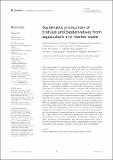Files in this item
Sustainable production of biofuels and bioderivatives from aquaculture and marine waste
Item metadata
| dc.contributor.author | Alvarado-Ramírez, Lynette | |
| dc.contributor.author | Santiesteban-Romero, Berenice | |
| dc.contributor.author | Poss, Guillaume | |
| dc.contributor.author | Sosa-Hernández , Juan Eduardo | |
| dc.contributor.author | Iqbal, Hafiz M. N. | |
| dc.contributor.author | Parra-Saldívar, Roberto | |
| dc.contributor.author | Bonaccorso, Alfredo D. | |
| dc.contributor.author | Melchor-Martínez, Elda M. | |
| dc.date.accessioned | 2023-01-11T15:30:03Z | |
| dc.date.available | 2023-01-11T15:30:03Z | |
| dc.date.issued | 2023-01-04 | |
| dc.identifier | 282831108 | |
| dc.identifier | 08689a20-096b-4d77-beb1-9b19e20865a2 | |
| dc.identifier | 85153608428 | |
| dc.identifier.citation | Alvarado-Ramírez , L , Santiesteban-Romero , B , Poss , G , Sosa-Hernández , J E , Iqbal , H M N , Parra-Saldívar , R , Bonaccorso , A D & Melchor-Martínez , E M 2023 , ' Sustainable production of biofuels and bioderivatives from aquaculture and marine waste ' , Frontiers in Chemical Engineering , vol. 4 , 1072761 . https://doi.org/10.3389/fceng.2022.1072761 | en |
| dc.identifier.issn | 2673-2718 | |
| dc.identifier.uri | https://hdl.handle.net/10023/26735 | |
| dc.description | Funding: This work received the financial support of the project GCRFNGR4/1388 "Algae bloom: waste resource for aquaculture and bioenergy industry in Mexico". This work was supported by the World Universities Network, Research Development Fund. | en |
| dc.description.abstract | The annual global fish production reached a record 178 million tonnes in 2020, which continues to increase. Today, 49% of the total fish is harvested from aquaculture, which is forecasted to reach 60% of the total fish produced by 2030. Considering that the wastes of fishing industries represent up to 75% of the whole organisms, the fish industry is generating a large amount of waste which is being neglected in most parts of the world. This negligence can be traced to the ridicule of the value of this resource as well as the many difficulties related to its valorisation. In addition, the massive expansion of the aquaculture industry is generating significant environmental consequences, including chemical and biological pollution, disease outbreaks that increase the fish mortality rate, unsustainable feeds, competition for coastal space, and an increase in the macroalgal blooms due to anthropogenic stressors, leading to a negative socio-economic and environmental impact. The establishment of integrated multi-trophic aquaculture (IMTA) has received increasing attention due to the environmental benefits of using waste products and transforming them into valuable products. There is a need to integrate and implement new technologies able to valorise the waste generated from the fish and aquaculture industry making the aquaculture sector and the fish industry more sustainable through the development of a circular economy scheme. This review wants to provide an overview of several approaches to valorise marine waste (e.g., dead fish, algae waste from marine and aquaculture, fish waste), by their transformation into biofuels (biomethane, biohydrogen, biodiesel, green diesel, bioethanol, or biomethanol) and recovering biomolecules such as proteins (collagen, fish hydrolysate protein), polysaccharides (chitosan, chitin, carrageenan, ulvan, alginate, fucoidan, and laminarin) and biosurfactants. | |
| dc.format.extent | 26 | |
| dc.format.extent | 2209856 | |
| dc.language.iso | eng | |
| dc.relation.ispartof | Frontiers in Chemical Engineering | en |
| dc.subject | Biofuels | en |
| dc.subject | Bioderivatives | en |
| dc.subject | Aquaculture | en |
| dc.subject | Marine waste | en |
| dc.subject | Circular economy | en |
| dc.subject | QD Chemistry | en |
| dc.subject | SH Aquaculture. Fisheries. Angling | en |
| dc.subject | SDG 8 - Decent Work and Economic Growth | en |
| dc.subject | SDG 12 - Responsible Consumption and Production | en |
| dc.subject | SDG 14 - Life Below Water | en |
| dc.subject | MCC | en |
| dc.subject.lcc | QD | en |
| dc.subject.lcc | SH | en |
| dc.title | Sustainable production of biofuels and bioderivatives from aquaculture and marine waste | en |
| dc.type | Journal item | en |
| dc.contributor.institution | University of St Andrews. School of Chemistry | en |
| dc.identifier.doi | https://doi.org/10.3389/fceng.2022.1072761 | |
| dc.description.status | Peer reviewed | en |
This item appears in the following Collection(s)
Items in the St Andrews Research Repository are protected by copyright, with all rights reserved, unless otherwise indicated.

